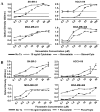Statin Drugs Plus Th1 Cytokines Potentiate Apoptosis and Ras Delocalization in Human Breast Cancer Lines and Combine with Dendritic Cell-Based Immunotherapy to Suppress Tumor Growth in a Mouse Model of HER-2pos Disease
- PMID: 32041347
- PMCID: PMC7157728
- DOI: 10.3390/vaccines8010072
Statin Drugs Plus Th1 Cytokines Potentiate Apoptosis and Ras Delocalization in Human Breast Cancer Lines and Combine with Dendritic Cell-Based Immunotherapy to Suppress Tumor Growth in a Mouse Model of HER-2pos Disease
Abstract
A dendritic cell-based, Type 1 Helper T cell (Th1)-polarizing anti-Human Epidermal Growth Factor Receptor-2 (HER-2) vaccine supplied in the neoadjuvant setting eliminates disease in up to 30% of recipients with HER-2-positive (HER-2pos) ductal carcinoma in situ (DCIS). We hypothesized that drugs with low toxicity profiles that target signaling pathways critical for oncogenesis may work in conjunction with vaccine-induced immune effector mechanisms to improve efficacy while minimizing side effects. In this study, a panel of four phenotypically diverse human breast cancer lines were exposed in vitro to the combination of Th1 cytokines Interferon-gamma (IFN-γ) and Tumor Necrosis Factor-alpha (TNF-α) and lipophilic statins. This combination was shown to potentiate multiple markers of apoptotic cell death. The combination of statin drugs and Th1 cytokines minimized membrane K-Ras localization while maximizing levels in the cytoplasm, suggesting a possible means by which cytokines and statin drugs might cooperate to maximize cell death. A combined therapy was also tested in vivo through an orthotopic murine model using the neu-transgenic TUBO mammary carcinoma line. We showed that the combination of HER-2 peptide-pulsed dendritic cell (DC)-based immunotherapy and simvastatin, but not single agents, significantly suppressed tumor growth. Consistent with a Th1 cytokine-dependent mechanism, parenterally administered recombinant IFN-γ could substitute for DC-based immunotherapy, likewise inhibiting tumor growth when combined with simvastatin. These studies show that statin drugs can amplify a DC-induced effector mechanism to improve anti-tumor activity.
Keywords: Ras; apoptosis; breast cancer; cytokine; statin; vaccine.
Conflict of interest statement
The authors declare that cancer vaccine technologies developed by GKK and BJC (patents pending) are currently licensed by Immunorestoration LLC, Warminster Pennsylvania, USA. The funders had no role in the design of the study; in the collection, analyses, or interpretation of data; in the writing of the manuscript, or in the decision to publish the results.
Figures








Similar articles
-
Th1 cytokines in conjunction with pharmacological Akt inhibition potentiate apoptosis of breast cancer cells in vitro and suppress tumor growth in vivo.Oncotarget. 2020 Jul 28;11(30):2873-2888. doi: 10.18632/oncotarget.27556. eCollection 2020 Jul 28. Oncotarget. 2020. PMID: 32774769 Free PMC article.
-
PIM kinase inhibitor AZD1208 in conjunction with Th1 cytokines potentiate death of breast cancer cellsin vitrowhile also maximizing suppression of tumor growthin vivo when combined with immunotherapy.Cell Immunol. 2024 Mar-Apr;397-398:104805. doi: 10.1016/j.cellimm.2024.104805. Epub 2024 Jan 8. Cell Immunol. 2024. PMID: 38244265
-
Th1 cytokines sensitize HER-expressing breast cancer cells to lapatinib.PLoS One. 2019 Jan 18;14(1):e0210209. doi: 10.1371/journal.pone.0210209. eCollection 2019. PLoS One. 2019. PMID: 30657766 Free PMC article.
-
Restoring Lost Anti-HER-2 Th1 Immunity in Breast Cancer: A Crucial Role for Th1 Cytokines in Therapy and Prevention.Front Pharmacol. 2016 Oct 6;7:356. doi: 10.3389/fphar.2016.00356. eCollection 2016. Front Pharmacol. 2016. PMID: 27766079 Free PMC article. Review.
-
Molecular immunological approaches to biotherapy of human cancers--a review, hypothesis and implications.Anticancer Res. 2006 Mar-Apr;26(2A):1113-34. Anticancer Res. 2006. PMID: 16619514 Review.
Cited by
-
Mutant p53, the Mevalonate Pathway and the Tumor Microenvironment Regulate Tumor Response to Statin Therapy.Cancers (Basel). 2022 Jul 19;14(14):3500. doi: 10.3390/cancers14143500. Cancers (Basel). 2022. PMID: 35884561 Free PMC article. Review.
-
Reprogramming of Lipid Metabolism Mediates Crosstalk, Remodeling, and Intervention of Microenvironment Components in Breast Cancer.Int J Biol Sci. 2024 Mar 3;20(5):1884-1904. doi: 10.7150/ijbs.92125. eCollection 2024. Int J Biol Sci. 2024. PMID: 38481820 Free PMC article. Review.
-
The impact of lipids on the cancer-immunity cycle and strategies for modulating lipid metabolism to improve cancer immunotherapy.Acta Pharm Sin B. 2023 Apr;13(4):1488-1497. doi: 10.1016/j.apsb.2022.10.027. Epub 2022 Nov 2. Acta Pharm Sin B. 2023. PMID: 37139414 Free PMC article. Review.
-
Nanomedicine for cancer targeted therapy with autophagy regulation.Front Immunol. 2024 Jan 4;14:1238827. doi: 10.3389/fimmu.2023.1238827. eCollection 2023. Front Immunol. 2024. PMID: 38239356 Free PMC article. Review.
-
Metabolism of Dendritic Cells in Tumor Microenvironment: For Immunotherapy.Front Immunol. 2021 Feb 24;12:613492. doi: 10.3389/fimmu.2021.613492. eCollection 2021. Front Immunol. 2021. PMID: 33732237 Free PMC article. Review.
References
-
- Czerniecki B.J., Koski G.K., Koldovsky U., Xu S., Cohen P.A., Mick R., Nisenbaum H., Pasha T., Xu M., Fox K.R., et al. Targeting HER-2/neu in early breast cancer development using dendritic cells with staged interleukin-12 burst secretion. Cancer Res. 2007;67:1842–1852. doi: 10.1158/0008-5472.CAN-06-4038. - DOI - PubMed
-
- Sharma A., Koldovsky U., Xu S., Mick R., Roses R., Fitzpatrick E., Weinstein S., Nisenbaum H., Levine B.L., Fox K., et al. HER-2 pulsed dendritic cell vaccine can eliminate HER-2 expression and impact ductal carcinoma in situ. Cancer. 2012;118:4354–4362. doi: 10.1002/cncr.26734. - DOI - PMC - PubMed
-
- Lowenfeld L., Mick R., Datta J., Xu S., Fitzpatrick E., Fisher C.S., Fox K.R., DeMichele A., Zhang P., Weinstein S., et al. Dendritic Cell Vaccination Enhances Immune Responses and Induces Regression of HER2pos DCIS Independent of Route: Results of Randomized Selection Design Trial. Clin. Cancer Res. 2016;23:2961–2971. doi: 10.1158/1078-0432.CCR-16-1924. - DOI - PubMed
Grants and funding
LinkOut - more resources
Full Text Sources
Medical
Research Materials
Miscellaneous

